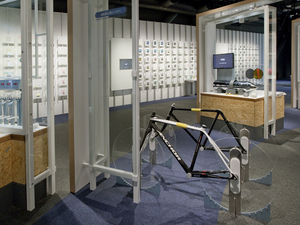Nagoya City Science Museum
TOP > Exhibition Guide > Floor Map> Weight Comparison
Weight Comparison



Purpose of Exhibition
In the exhibition "Weight Comparison", you will lift 14 different kinds of materials with 10cm length, width and height, and experience how heavy each material is. You will be surprised by weight differences depending on materials even if they are all the same size.
In the exhibition "Weight Comparison of Two Bicycles", you can experience weight difference by lifting a steel frame bicycle and a carbon frame bicycle.
Additional Knowledge
[Weight Comparison]
Weight varies depending on materials. Metal is generally heavy. Some plastics are made with light materials and float on water. Ceramics come in the middle.
Weight of a material is one of the important factors in the selection of the material used for a product. Except in the case where the weight of a product is the main function for that product, such as paperweights and anchoring materials, products with light materials are generally said to be functional. A light material is easy to carry around and a light car is more fuel-efficient. Furthermore, strength is an important factor in products. The less the amount of material is used, the lighter a product will weigh. But it loses its strength required. It is ideal to make a product with light and strong materials, but it generally costs much more.
Additionally, not only the kind of material, but also its shape is involved in determining strength, even when amounts of material are the same. For example, a pipe with a thick radius is stronger than that of a bar.
[Weight Comparison of Two Bicycles]
The material used for the frame of bicycles primarily includes steel (iron and steel), aluminum alloy, titanium, and carbon resin.
The weight of the frame made of steel in this exhibition is about 5 kilograms, and the one made of carbon weighs about 1 kilogram. Surprisingly, there is a five- time difference. However, the ratio of the weight is about twice as heavy because safety covers are applied in this exhibit.
The steel frame is heavy. On the other hand, it is easy to repair and has durability. Moreover, if it is maintained well, it can be used for a long time. There are various kinds of steel (iron and steel) when talking of steel. For example, the material that is called chromium molybdenum steel (an alloy made with chrome and molybdenum added in iron) has a high grade strength. Therefore, since it requires fewer materials to keep its strength, its weight can be reduced. The frame (the one exhibited) sold by the name of simply 'steel' is used for practical use, such as for a bicycle that carries baggage. The expensive frame made of chromium molybdenum steel is primarily used for mountain biking and as a bicycle for cycling.
Carbon fiber-reinforced plastic, simply and often called carbon, is made by weaving carbon fibers and putting the fibers over and over like a pile. Thereafter, plastic is absorbed into it and it is heated and hardened.
Plastic has an advantage, in that it is light, but the disadvantage is that the modulus of elasticity is small (transformed large with small power). Carbon fiber-reinforced plastic is a composite material which covers its disadvantage with carbon fibers. It is a material where its performance such as strength is swayed depending on the way carbon fibers are covered. A carbon frame can be transformed into any shape and is very light, but it is expensive. It is also used as a racing bicycle.
So, as for bicycle frames, there are various materials with different weights even though their strengths and functions are the same.
Article by Keiko Ishida and Yoshitaka Yamada, curators
